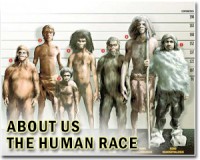| . |  |
. |
by Staff Writers Bristol UK (SPX) Jan 13, 2010 The teeth of a 30,000-year-old child are shedding new light on the evolution of modern humans, thanks to research from the University of Bristol published in PNAS. The teeth are part of the remarkably complete remains of a child found in the Abrigo do Lagar Velho, Portugal and excavated in 1998-9 under the leadership of Professor Joao Zilhao of the University of Bristol. Classified as a modern human with Neanderthal ancestry, the child raises controversial questions about how extensively Neanderthals and modern human groups of African descent interbred when they came into contact in Europe. 'Early modern humans', whose anatomy is basically similar to that of the human race today, emerged over 50,000 years ago and it has long been the common perception that little has changed in human biology since then. When considering the biology of late archaic humans such as the Neanderthals, it is thus common to compare them with living humans and largely ignore the biology of the early modern humans who were close in time to the Neanderthals. With this in mind, an international team, including Professor Zilhao, reanalysed the dentition of the Lagar Velho child (all of its deciduous - milk - teeth and almost all of its permanent teeth) to see how they compared to the teeth of Neanderthals, later Pleistocene (12,000-year-old) humans and modern humans. Employing a technique called micro-tomography which uses x-rays to create cross-sections of 3D-objects, the researchers investigated the relative stages of formation of the developing teeth and the proportions of crown enamel, dentin and pulp in the teeth. They found that, for a given stage of development of the cheek teeth, the front teeth were relatively delayed in their degree of formation. Moreover, the front teeth had a greater volume of dentin and pulp but proportionally less enamel than the teeth of recent humans. The teeth of the Lagar Velho child thus fit the pattern evident in the preceding Neanderthals, and contrast with the teeth of later Pleistocene (12,000-year-old) humans and living modern humans. Professor Zilhao said: "This new analysis of the Lagar Velho child joins a growing body of information from other early modern human fossils found across Europe (in Mladec in the Czech Republic, Pestera cu Oase and Pestera Muierii in Romania, and Les Rois in France) that shows these 'early modern humans' were 'modern' without being 'fully modern'. Human anatomical evolution continued after they lived 30,000 to 40,000 years ago." The team was led by Priscilla Bayle (Museum National d'Histoire Naturelle, France) and Roberto Macchiarelli (Universite de Poitiers, France) and included Erik Trinkaus (Professor of Anthropology at Washington University, St.-Louis, Cidalia Duarte (Camara Municipal do Porto, Portugal), and Arnaud Mazurier (CRI-Biopole-Poitiers, France). Paper: Dental maturational sequence and dental tissue proportions in the early Upper Paleolithic child from Abrigo do Lagar Velho, Portugal by Priscilla Bayle, Roberto Macchiarelli, Erik Trinkaus, Cidalia Duarte, Arnaud Mazurier, and Joao Zilhao.
Share This Article With Planet Earth
Related Links All About Human Beings and How We Got To Be Here
 3-D and Web hot trends in adult entertainment
3-D and Web hot trends in adult entertainmentLas Vegas, Nevada (AFP) Jan 10, 2010 A 3-D mania stoked by stunning new television sets and the blockbuster film "Avatar" is being embraced by a porn industry notorious for helping new technologies access homes. Bad Girls In 3D used an AVN Adult Entertainment Expo that ended Sunday in Las Vegas to unveil an unprecedented online library exclusively in the format and a first-of-a-kind "turnkey digital 3-D viewing system." ... read more |
|
| The content herein, unless otherwise known to be public domain, are Copyright 1995-2009 - SpaceDaily. AFP and UPI Wire Stories are copyright Agence France-Presse and United Press International. ESA Portal Reports are copyright European Space Agency. All NASA sourced material is public domain. Additional copyrights may apply in whole or part to other bona fide parties. Advertising does not imply endorsement,agreement or approval of any opinions, statements or information provided by SpaceDaily on any Web page published or hosted by SpaceDaily. Privacy Statement |